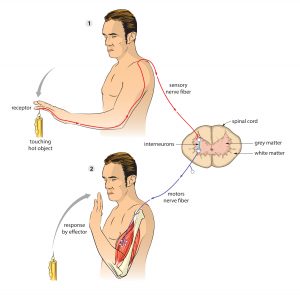Muscle activity occurs in a simpler manner when controlled by the peripheral nervous system in comparison to the control exerted by the central nervous system. This system provides a vital protective mechanism to the muscle. For example:
- If the muscle is stretched quickly the sensory receptor within the muscle detects this. The sensory information is sent along a sensory nerve pathway to the spinal cord. The information is translated into a motor response within the spinal cord and is sent directly back to the muscle via a motor nerve pathway. The muscle then responds immediately by contracting to protect itself from damage. This is known as the stretch reflex and is part of the body’s saving reactions. Gravity, acting downwards on the muscles of the body and when lifting loads, produces stretches to muscles thus triggering the reflex response.
- If the body sustains trauma or sustained pressure, sensory receptors in the form of pain or pressure receptors receives and sends this information via a sensory nerve pathway to the spinal cord and returns the information via a motor nerve pathway:
o The response to pain is muscle contraction to withdraw the body part from the source of the pain, to protect it from further damage.
o The response, in the case of pressure, is that muscles will contract to change the body’s position for comfort.
All of the above examples are automatic responses which the body produces at a peripheral level to protect itself from damage. All involve an increase in muscle contraction.
The brain works with the peripheral nervous system and continually responds to changes in muscle contraction. It acts to maintain the balance between muscle contraction and relaxation so the muscles continue to work effectively, in pairs and groups, to produce normal patterns of movement.
